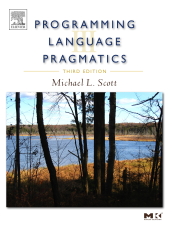
The ubiquity of computers in everyday life in the 21st century justifies the centrality of programming languages to computer science education. Programming languages is the area that connects the theoretical foundations of computer science, the source of problem-solving algorithms, to modern computer architectures on which the corresponding programs produce solutions. Given the speed with which computing technology advances in this post-Internet era, a computing textbook must present a structure for organizing information about a subject, not just the facts of the subject itself. In this book, Michael Scott broadly and comprehensively presents the key concepts of programming languages and their implementation, in a manner appropriate for computer science majors.
The key strength of Scott’s book is that he holistically combines descriptions of language concepts with concrete explanations of how to realize them. The depth of these discussions, which have been updated in this third edition to reflect current research and practice, provide basic information as well as supplemental material for the reader interested in a specific topic. By eliding some topics selectively, the instructor can still create a coherent exploration of a subset of the subject matter. Moreover, Scott uses numerous examples from real languages to illustrate key points. For interested or motivated readers, additional in-depth and advanced discussions and exercises are available on the book’s companion CD, enabling students with a range of interests and abilities to further explore on their own the fundamentals of programming languages and compilation.
I have taught a semester-long comparative programming languages course using Scott’s book for the last several years. I emphasize to students that my goal is for them to learn how to learn a programming language, rather than to retain detailed specifics of any one programming language. The purpose of the course is to teach students an organizational framework for learning new languages throughout their careers, a certainty in the computer science science field. To this end, I particularly like Scott’s chapters on programming language paradigms (i.e., functional, logic, object-oriented, scripting), and my course material is organized in this manner. However, I also have included foundational topics such as memory organization, names and locations, scoping, types, and garbage collection—all of which benefit from being presented in a manner that links the language concept to its implementation details. Scott’s explanations are to the point and intuitive, with clear illustrations and good examples. Often, discussions are independent of previously presented material, making it easier to pick and choose topics for the syllabus. In addition, many supplemental teaching materials are provided on the Web.
Of key interest to me in this new edition are the new Chapter 15 on run-time environments and virtual machines (VMs), and the major update of Chapter 12 on concurrency. Given the current emphasis on virtualization, including a chapter on VMs, such as Java’s JVM and CLI, facilitates student understanding of this important topic and explains how modern languages achieve portability over many platforms. The discussion of dynamic compilation and binary translation provides a contrast to the more traditional model of compilation presented earlier in the book. It is important that Scott includes this newer compilation technology so that a student can better understand what is needed to support the newer dynamic language features described. Further, the discussions of symbolic debugging and performance analysis demonstrate that programming language and compiler technology pervade the software development cycle.
Besides these major changes, this edition features updated examples (e.g., in X86 code, in C rather than Pascal) and enhanced discussions in the context of modern languages such as C#, Java 5, Python, and Eiffel. Presenting examples in several programming languages helps students understand that it is the underlying common concepts that are important, not their syntactic differences.
In summary, Michael Scott’s book is an excellent treatment of programming languages and their implementation. This new third edition provides a good reference for students, to supplement materials presented in lectures. Several coherent tracks through the textbook allow construction of several “flavors” of courses that cover much, but not all of the material. The presentation is clear and comprehensive with language design and implementation discussed together and supporting one another.
Congratulations to Michael on a fine third edition of this wonderful book!
 Back to the book home page
Back to the book home page
